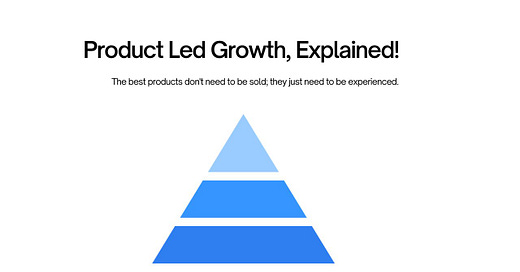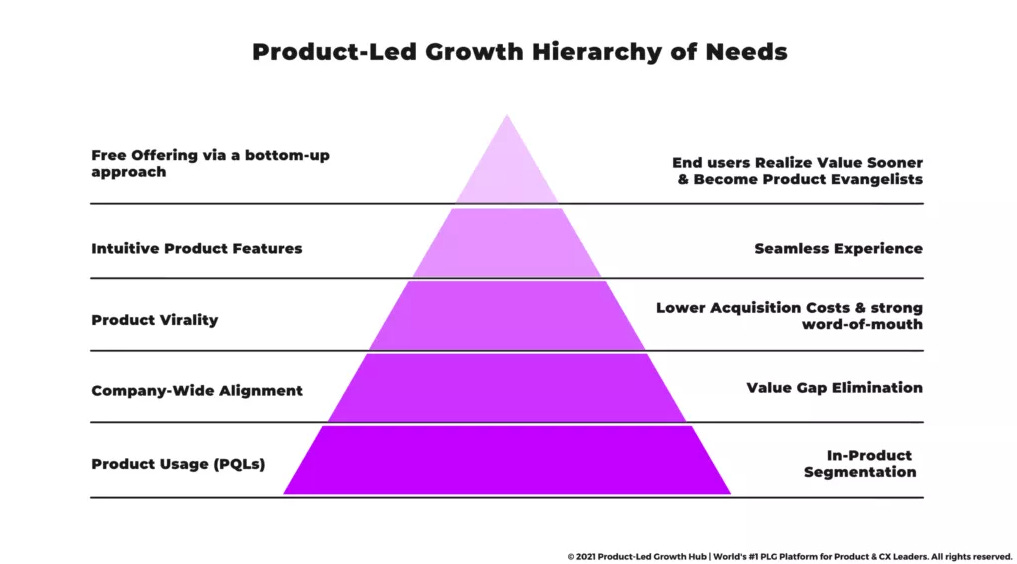Product Led Growth, Explained!
The best products don't need to be sold; they just need to be experienced.
What is product-led growth?
Imagine a product so magical, it practically sells itself. No pushy salespeople, no confusing demos, just a delightful experience that leaves users saying, "Take my money!" Welcome to the world of product-led growth (PLG), where the product becomes the ultimate charmer, salesman, and cheerleader, all rolled into one.
Think of it like this: you're strolling through a bustling marketplace, and instead of being bombarded by hawkers, you stumble upon a hidden gem. Its intuitive design beckons you to explore, its features unveil themselves like treasures, and suddenly, you're hooked. You don't need anyone to tell you its value; you experience it firsthand. That's PLG in action.
But wait, there's more! This isn't just a one-time encounter; it's a love story. The product keeps surprising you with its hidden depths, its clever integrations, and its unexpected ways to make your life easier. You become its champion, spreading the word to your friends, and before you know it, you're part of a thriving community of fellow enthusiasts.
That's the magic of PLG. It's about building products that people love to use, not just buy. It's about empowering users to discover value on their own, not force-feeding it to them. It's about creating a movement around your product, where growth is organic, sustainable, and fueled by genuine passion.
Intrigued? Want to know how to weave this magic into your own product? Keep reading, because we're about to dive deep into the secrets of PLG:
Unlocking the freemium model: How to give users a taste of the good life without asking for their credit card.
Designing for "aha!" moments: Creating features that make users shout, "I get it!" and fall in love with your product.
Building communities that convert: Turning users into advocates who spread the word and fuel organic growth.
Measuring success beyond the bottom line: Tracking the metrics that matter most in the PLG world.
So, are you ready to ditch the sales pitch and let your product do the talking? Join us on this journey to product-led growth and discover the power of building something truly captivating.
Why Product-Led Growth is important?
The benefits are a symphony of sweet sounds for your ears (and bottom line):
Faster growth: Ditch the slow, expensive dance of traditional sales. PLG lets your product do the heavy lifting, acquiring and converting users organically at breakneck speed.
Happier customers: PLG is all about empowering users to discover value on their own terms. This breeds trust, loyalty, and sky-high satisfaction scores.
Lower costs: Say goodbye to bloated marketing budgets! PLG leverages your product itself as the marketing engine, slashing acquisition costs and boosting ROI.
Scalability: No more hitting a wall with limited sales teams. PLG thrives on virality, letting your happy users do the marketing for you, reaching new heights with ease.
Product-centric culture: PLG fosters a laser focus on building the best damn product possible. Every team, from devs to designers, sings from the same user-centric hymn sheet.
1. Shifting Customer Landscape: Today's users are tech-savvy and value their time. They expect instant gratification and effortless experiences. PLG caters to this shift by:
Empowering users with self-service tools and resources: No more lengthy sales calls or complex demos. Users can explore and discover the product's value on their own time.
Prioritizing intuitive design and ease of use: Frictionless interfaces and clear value propositions reduce learning curves and increase user satisfaction.
Providing tailored value through freemium models: Users can experience the core functionality before committing to a paid plan, building trust and confidence.
2. Scalability and Efficiency: Compared to traditional sales-led models, PLG offers significant advantages in terms of scale and efficiency:
Lower acquisition costs: Organic growth through virality and word-of-mouth reduces reliance on expensive sales and marketing campaigns.
Faster user onboarding: Self-service onboarding processes allow for quicker acquisition and activation of new users.
Reduced operational overhead: Automation and self-service capabilities free up resources for product development and customer success initiatives.
3. Deeper Customer Relationships: PLG goes beyond simply acquiring users; it fosters deeper and more sustainable relationships:
Value-driven acquisition: Users choose your product because they see its inherent value, leading to stronger buy-in and loyalty.
Building communities: PLG often cultivates engaged user communities where members share tips, provide feedback, and advocate for the product.
Data-driven insights: Tracking user behavior and engagement provides valuable feedback for improving the product and catering to user needs.
4. Competitive Advantage: In today's crowded market, PLG can give your business a significant edge:
Faster iteration and innovation: User feedback directly shapes product development, enabling quicker adaptation to changing needs and trends.
Differentiation through delightful experiences: By prioritizing user experience and delight, PLG companies can stand out from competitors with less user-centric approaches.
Building a loyal customer base: Happy users become brand ambassadors, attracting more users and driving organic growth.
Ultimately, PLG is not just a growth strategy; it's a mindset shift. It's about putting the user at the center of everything you do and building a product that people love to use. In today's digital landscape, this user-centric approach is proving to be a powerful formula for success.
Understanding Product-Led Growth Metrics and Principles
Product-led growth (PLG) is a strategy where user acquisition, engagement, and conversion are primarily driven by the product itself. To ensure success, it's crucial to understand key metrics and principles that guide your PLG journey.
Key Metrics:
Acquisition:
Free trial conversion rate: Measures how effectively your free trial converts users to paying customers.
Organic traffic: Tracks how many users discover your product naturally, without paid marketing efforts.
Viral coefficient: Shows how many new users each existing user brings in on average.
Engagement:
Time to first value (TTV): Measures the time it takes for users to experience the main benefit of your product.
Daily/monthly active users (DAUs/MAUs): Indicates how often users engage with your product.
Feature adoption rate: Shows how frequently users explore and utilize different features.
Conversion:
Product-qualified lead (PQL) conversion rate: Measures how successfully your product identifies and converts users with high purchase intent.
Average revenue per user (ARPU): Tracks the average revenue generated per user.
Net Promoter Score (NPS): Shows how likely users are to recommend your product to others.
Core Principles:
Prioritize user experience: Your product should be intuitive, delightful, and solve a real problem for users. Invest in user research, design thinking, and A/B testing to ensure a seamless and satisfying experience.
Offer a compelling freemium model: Let users experience the core value of your product without paying upfront. This builds trust and encourages conversion at their own pace.
Embrace virality: Design features that encourage users to share your product with their networks. Think referral programs, social integrations, and seamless collaboration tools.
Data is your friend: Track user behavior, measure key metrics, and iterate based on insights. Learn from what works and what doesn't to constantly optimize your PLG strategy.
Focus on value, not features: Don't just add features; prioritize features that deliver demonstrably positive outcomes for users.
Build a community: Foster a community around your product where users can connect, share tips, and provide feedback.
How the Product-Led Growth Model Works
Product-Led Growth (PLG) is a business strategy where the product itself is the primary driver of user acquisition, activation, and retention. Unlike traditional sales-led models, PLG emphasizes intuitive and delightful user experiences that empower users to discover and unlock value on their own. Here's how it works:
1. Frictionless Acquisition:
Freemium models: Offer a basic version of your product for free, allowing users to experience its core value without commitment.
Self-service onboarding: Provide clear instructions and resources to guide users through the product independently.
Referral programs: Encourage existing users to invite their networks, leveraging word-of-mouth marketing.
Organic reach: Optimize your product for discoverability through search engines and app stores.
2. Delightful Engagement:
Intuitive interface: Design a product that is easy to navigate and understand, even for first-time users.
Aha! moments: Build in features that deliver clear value and unlock new ways for users to achieve their goals.
Progressive onboarding: Gradually introduce advanced features as users become comfortable with the basics.
Seamless integrations: Connect your product with other tools and services users already rely on.
3. Organic Conversion:
Value-based pricing: Offer tiered plans that align with user needs and the value they derive from the product.
Frictionless upgrade paths: Make it easy for users to transition to paid plans within the product.
In-app messaging and nudges: Provide personalized guidance and recommendations to encourage conversion at the right time.
Social proof and testimonials: Showcase success stories and positive feedback from existing users to build trust and confidence.
4. Virtuous Cycle:
Happy users: Delighted users become your biggest advocates, spreading the word and driving organic acquisition.
Data-driven insights: Track user behavior and engagement to identify areas for improvement and optimize the product for growth.
Continuous iteration: Constantly experiment and refine your PLG strategy based on data and user feedback.
Benefits of PLG:
Lower acquisition costs: Organic growth through freemium and virality reduces reliance on expensive sales and marketing efforts.
Higher user engagement: Intuitive experiences and value discovery lead to deeper user engagement and retention.
Faster growth: Organic acquisition and viral loops can drive rapid user growth, outpacing traditional sales-led models.
Stronger customer relationships: Building trust through value-driven experiences fosters stronger and more loyal customer relationships.
Examples of PLG Companies:
Slack, Zoom, Dropbox, Canva, Airtable, Figma, Atlassian, Spotify, Duolingo, Pinterest
Remember: PLG is not a magic formula. It requires careful planning, a focus on user-centricity, and continuous optimization to achieve success. However, when done right, it can unlock powerful growth for your product and build a thriving community of engaged users.
Examples of Product-Led Companies and a Case Study:
Examples:
B2B: Slack, Zoom, Dropbox, Atlassian, Canva, Airtable, Hubspot, Calendly, Zendesk, Figma
B2C: Spotify, Pinterest, Duolingo, Instagram, TikTok, Netflix, Uber, Airbnb, Grammarly, Headspace
Case Study: Zoom
Challenge: Prior to the pandemic, video conferencing was dominated by complex, enterprise-focused solutions. Zoom needed to break into this market with a user-friendly, accessible alternative.
Product-Led Strategy:
Freemium model: Offered a free tier with basic features, encouraging organic adoption and virality.
Simple and intuitive interface: Designed for ease of use, minimizing the learning curve.
Seamless integration with popular tools: Made collaboration and communication effortless.
Strong network effect: As more users joined, the value proposition of Zoom grew for everyone.
Results:
Explosive growth during the pandemic: Reached 100 million daily active users in 2020.
High user satisfaction and retention: Net Promoter Score (NPS) above 70.
Successful transition to paid plans: Over 50% of users subscribe to paid tiers.
Zoom's success demonstrates the power of a product-led approach. By prioritizing user experience, offering a compelling freemium model, and fostering a network effect, Zoom achieved rapid growth and established itself as a leader in the video conferencing market.






